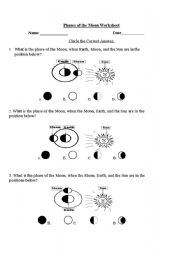
|
Phases of the Moon
By observing the Moon over a period of several weeks, one will notice that the Moon rises and sets at different times each night, and that there is a regular progression through lunar phases. In a synodic month, the Moon progresses through one lunar cycle and will vary between being a completely dark new moon and a fully illuminated full moon . The lunar phases are caused because the orbit of the Moon around the Earth will vary the Moon’s position in relation to the Sun. Half of the Moon is always lit by the Sun, but the portion that we see will change depending on where the Moon is in its orbit. The synodic month “begins” at new moon. Because the Moon is in the same part of the sky as the Sun, the illuminated half of the Moon is not facing us and is not visible. During new moon, the Moon rises and sets at the same time as the Sun, and is therefore in the sky during the day. There is then a progression through the growing crescent phase until we see the right half illuminated; this is known as a first quarter moon. After the first quarter phase, there is another progression, this time through the waxing gibbous phases. The Moon becomes full about 15 days after new moon. During a full moon, the Moon is opposite the Sun and is fully lit. The Moon rises at sunset and sets at sunrise when it is full, so the Moon is always visible in the night sky while full. The Moon then begins to wane through another gibbous phase until it reaches its next phase called last or third quarter moon, and again proceeds through another crescent phase, ultimately returning to the new moon almost 30 days later. The saying “Once in a blue moon” is a referral to when two full moons occur in the same calendar month.
Level:elementary
Age: 5-12
Downloads:22 |
|
Copyright 30/1/2009 Bez
Publication or redistribution of any part of this
document is forbidden without authorization of the
copyright owner.
|


see more worksheets by yodbez
|